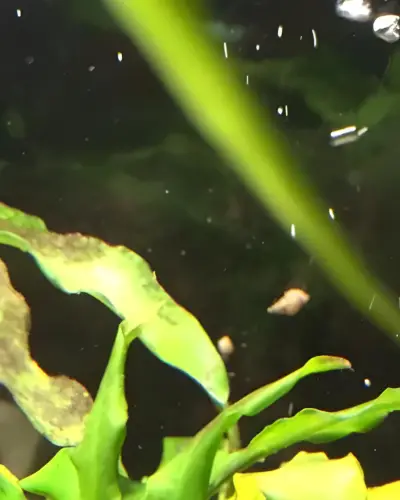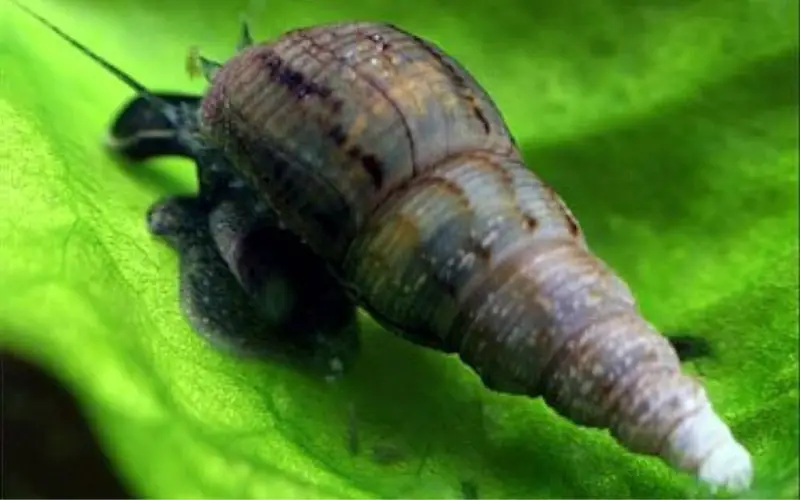Have you ever noticed a strange, gelatinous blob stuck to the glass of your aquarium? Before you reach for the algae scraper, hold on! You might be looking at a clutch of Malaysian trumpet snails eggs.
These fascinating little creatures reproduce rapidly, and they are often considered a pest by some and a helpful addition by others.
Understanding their reproductive process, particularly identifying and caring for Malaysian trumpet snail eggs, can be key to managing their population in your aquarium.

So, are you curious to unravel the mysteries of these slimy bundles and learn more about the fascinating world of trumpet snails? Let’s dive in!
Table of Contents
ToggleDo Malaysian Trumpet Snails Lay Eggs?
Malaysian Trumpet Snails (MTS) are a snail species native to Southeast Asia. They are live-bearing snails, which means that they do not lay eggs like other species of snails. Instead, they give birth to live young. This unique reproductive trait helps them grow their population rapidly in aquariums.
Female MTS can give birth to many living snails at once, leading to potential snail infestations if they are not kept in moderation. It is important to provide plenty of plant cover, sand or gravel substrate, and organic matter for the baby snails to feed on.

Malaysian red-rimmed melania Snails are beneficial in aquariums as they help aerate the substrate and eat leftover fish food and waste. Tankmates like puffer fish, loaches, and shrimp may crush their conical shells, so it is advised to keep them cautiously.
What Do Malaysian Trumpet Snail Eggs Look Like: (Deciphering the Blob)
Malaysian trumpet snail eggs aren’t quite as eye-catching as their spiraled shell parents, but they have a unique appearance that, once learned, is easy to identify. Here’s what to look for:
- Shape and Size: The eggs are encased in a transparent, gelatinous mass, often compared to a blob of jelly. Depending on the large number of eggs within, this mass can be as small as a pea or as large as a grape.
- Color: The egg mass is typically clear or slightly yellow, showing the tiny snails developing inside.
- Location: These jelly blobs are usually attached to surfaces within the aquarium, such as the glass walls, plant leaves, decorations, or even the substrate.
Differentiating from Other Snails: Other aquarium snail tank mates lay eggs, too, so it’s important to note the distinctions. For example, mystery snail eggs are laid above the waterline in a hardened, pink clutch, while nerite snail eggs appear as tiny white dots firmly attached to surfaces.
Breeding Malaysian Trumpet Snails
MTS Snails are prolific breeders in freshwater aquariums. They are a type of tropical Thiaridae snail commonly used to help keep aquarium substrate clean.
Breeding these freshwater snails is relatively easy, as they will reproduce on their own without much intervention from the aquarium owner.
The snails lay their eggs in clusters in a dark corner or underneath live plants in the tank. The snail shells are typically conical in shape with a distinctive whorl pattern. In ideal conditions, the eggs will hatch inside the female snail’s empty brood pouch.
Once hatched, the young snails burrow into the substrate to hide and feed on algae and detritus. Malaysian Trumpet Snails are almost always more active at night, so spotting their presence during these hours may be easier.
To encourage the reproduction of Malaysian trumpet snails in your tank, it is recommended that you provide plenty of live plants that you can buy from your nearby pet store and a varied diet for the snails.
Additionally, keeping the water clean and well-filtered will help support the snail population’s growth.
Malaysian Trumpet Snails Eggs Caring Tips
When it comes to caring for the eggs of trumpet snail Melanoides, also known as Malaysian Trumpet Snails, there are a few key pieces of advice to keep in mind. These aquatic critters are excellent for your tank as they help clean up excess food or waste.
If you notice eggs in your tank, remove them promptly to prevent overpopulation. If you’re looking for another option, consider introducing some pond snails to help keep the population in check.
Following these tips can ensure a better experience caring for these fascinating creatures.
– Optimum aquarium temperature
Trumpet snails are originally from Africa and prefer warmer waters. The optimum aquarium temperature for them is around 75-80 degrees Fahrenheit. If the temperature exceeds this range, they will become stressed, and their growth may be affected.
It is important to keep a close eye on the water temperature to ensure the health of your trumpet snails. If they hit temperatures below 65 degrees, they will slow down and may even go into a state of hibernation.
If you notice any abnormal behavior in your trumpet snails, such as faster breathing or lethargy, it could be a sign that the temperature is not optimal. Consult with a local fish store (LFS) for advice on properly maintaining the temperature in your aquarium.
– Recommended Malaysian Trumpet Snails pH
Although Trumpet snails can live in a wide range of water parameters, the recommended pH of Malaysian snails should be maintained between 7.0 and 8.0 as they will thrive in slightly alkaline water.
With their ability to burrow and root in the substrate, MTS Snails help aerate the soil and prevent anaerobic pockets. Last night, a male snail was observed moving across the tank, possibly searching for a mate like Melania. Watch the video on lung fluke infestation in snails for proper care guidance.
– Trumpet Snails Supplement feeding
When feeding trumpet snails, they primarily rely on algae and decaying plant matter for nutrition. However, supplement feeding can be beneficial in ensuring they receive enough nutrients to thrive in your aquarium. By providing sinking pellets or algae wafers, you can support the health and longevity of your trumpet snails.
Commonly Asked Questions about Malaysian Trumpet Snail Eggs Appearance and Care (FAQs)
How many eggs do Malaysian trumpet snails lay?
Malaysian trumpet snails are livebearers aquatic animals, meaning they will only give birth to live young instead of laying eggs. They can produce as many as 70 baby snails at a time!
Do Malaysian trumpet snails eat eggs?
Malaysian trumpet snails are primarily detritivores, meaning they feed on decaying organic matter and algae, not eggs.
Do Malaysian trumpet snails eat fish eggs?
Yes, Malaysian trumpet snails are opportunistic feeders and will likely eat fish eggs if they find them. Consider breeder traps or removing snails for successful hatching.
Do Malaysian trumpet snails reproduce a lot?
Yes, Malaysian trumpet snails are prolific breeders, giving birth to as many as 70 live young at a time, leading to rapid population growth.
Do Malaysian trumpet snails breed easily?
Yes, Malaysian trumpet snails reproduce rapidly. A single snail can quickly populate a tank as they are parthenogenetic, meaning females can reproduce without males.
How did Malaysian trumpet snails eggs get in my tank?
Malaysian trumpet snail eggs likely entered your tank through new plants, substrate, or decorations. Their tiny eggs are easily overlooked and can hitchhike into aquariums unnoticed.
Can Malaysian trumpet snails live in stagnant water?
Yes, Malaysian trumpet snails can tolerate stagnant water. They thrive in slow-moving environments like ponds and ditches but prefer good water quality for optimal health.
Conclusion
Understanding the life cycle of any creature in your aquarium is key to maintaining a balanced and healthy ecosystem. Malaysian trumpet snails melanoides tuberculata, often viewed with curiosity and apprehension, play a crucial role in this delicate balance. Their reproductive habits, particularly the appearance and care of Malaysian trumpet snail eggs, are fascinating aspects of their existence.
While some aquarists may see a population boom as a nuisance, it’s important to recognize the benefits these snails bring. They are nature’s clean-up crew, diligently consuming leftover food, decaying plant matter, and algae, thus contributing to a cleaner and healthier environment for your fish and plants.
The burrowing snail activities help aerate the substrate, promoting beneficial bacteria growth and overall tank health. Remember, a sudden surge in the snail population often indicates abundant food sources.
You can maintain a balanced ecosystem where snails and other tank inhabitants thrive by managing feeding practices and ensuring efficient filtration. So, the next time you spot a cluster of Malaysian trumpet snails eggs, take a moment to appreciate the circle of life unfolding within your aquarium and the role these little snails play in keeping it healthy and vibrant.
You might also like
- What Eats Malaysian Trumpet Snails! (Problem Solved)
- How to Get Rid of Malaysian Trumpet Snails! (3 Proven Ways)
- Assassin Snail Vs Malaysian Trumpet Snail: Tankmates or Foes
- How Fast Do Malaysian Trumpet Snails Breed: (Ultimate Guide)
- How Big Do Malaysian Trumpet Snails Get: (Expert Guide)
- What Do Malaysian Trumpet Snails Eat: (Comprehensive Guide)
- Are Malaysian Trumpet Snails Good for Aquarium: (Pros and Cons)
- Breeding Malaysian Trumpet Snails: Complete Beginner’s Guide
- Spot Baby Malaysian Trumpet Snails With These 3 Easy Clues!





